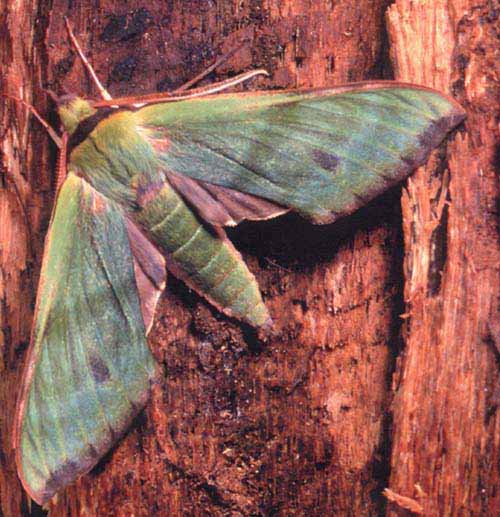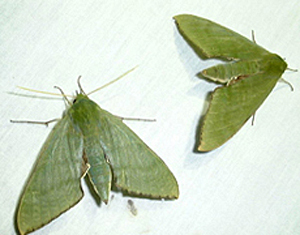Tinostoma smaragditis
Tinostoma smaragditis
tye-noh-STOH-muhmmsmaghr-ag-DYE-tuhs
(Meyrick, 1899)

Tinostoma smaragditis courtesy of
D.J. Preston & A. Heddle, HBS
This site has been created by
Bill Oehlke at oehlkew@islandtelecom.com
Comments, suggestions and/or additional information are welcomed by Bill.
TAXONOMY:
Family: Sphingidae, Latreille, 1802
Subfamily: Smerinthinae, Grote & Robinson, 1865
Tribe: Sphingini, Latreille, 1802
Genus: Tinostoma Rothschild & Jordan...........
Species: smaragditis (Meyrick, 1899)
|
MIDI MUSIC
.....It's a Wonderful World.....
copyright C. Odenkirk
ON.OFF
<bgsound src="world.mid" LOOP=FOREVER>
|
DISTRIBUTION:
The Fabulous Green Sphinx of Kauai, Tinostoma smaragditis
flies in Hawaii.
This moth is also known as "Wahine Omao", The Green Woman.
"The first specimen of Tinostoma smaragditis ever discovered in Hawaii was found at the turn of
the century by a local family who handed it over to Mr. Perkins, the entomologist working in Hawaii
for the British Natural History Museum.
He was amazed by the discovery, and despite attempts to locate other specimens was unable to do so.
In the 1920s, August Kusche was sent to the Hawaiian islands in search of this, now mythical, animal, and he too failed
to locate it.
"A couple of specimens, over the years were discovered by various people, who wondered what it was they had
stumbled over. One was found sitting on a can of Cambell's soup after a night camping. Another on the lid of a
garbage can in the Kokee region.
"When the tracking station was built in the 1970s, its bright lights
attracted various moths from the Kokee area. Some of these have been the Fabulous Green Sphinx
so that we now have around 12 specimens of this moth. And yet, whenever anyone has hunted it,
searched for its larvae, set up lights in the surrounding forest, it has never appeared, remaining an
enigma. " |  |
This beautiful, rare moth was rediscovered by Dr. Adam Asquith in January of 1998.
FLIGHT TIMES:
Tinostoma smaragditis adults have been taken in April and May and again from
November to January.
ECLOSION:
Pupae probably wiggle to surface from subterranean chambers just prior to eclosion.
SCENTING AND MATING:Females call in the males with a pheromone released from a gland at the tip of the
abdomen. Adults probably take nectar from flowers.
EGGS, LARVAE, PUPAE:
Larvae feed on ???
Return to Sphingidae Index
Return to Sphingini Tribe

